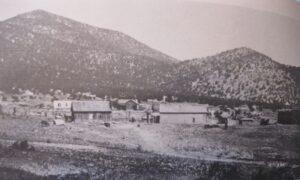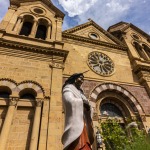
In 1821, Spain signed the Treaty of Córdova and New Mexico became part of the new Republic of Mexico. In 1827, placer gold was discovered in the Ortiz Mountains south of Santa Fe, the mining camp of Dolores sprang up almost overnight, and the first gold rush in the West began – 22 years before the California gold rush.
In the early 1830s the gold quartz veins, source of the placer deposits, were discovered and developed by two wealthy Santa Fe merchants, Jose Francisco Ortiz and Ignacio Cano, on the Santa Rosalia lode about a mile up the hill from Dolores. This led to a large influx of miners from as far away as Missouri. The population after this is unknown, but there are estimates that it reached over 2,000 people.
In 1870, Real de Dolores had a population of 150, an ore stamping mill, a mercury separation facility, a store and a church, Nuestra Señora de los Dolores. In May 1900, Thomas Edison constructed a mill to test a new separation process that used an electric blower and static electricity to separate heavier gold from the lighter waste material. An electric line was run from Madrid to power the mill and it was reported that the mill’s electric lights could be seen from Santa Fe. The project was unsuccessful, and Edison abandoned it six months later.
By 1905, very little gold remained, and Dolores was abandoned. It is estimated that, during its 80-year existence, one hundred thousand ounces of gold were recovered.
Today, the ruins of Dolores are on private property and are not open to the public. One can drive to the fence line (about two miles north of Cerrillos on NM 14) and see what’s left.

